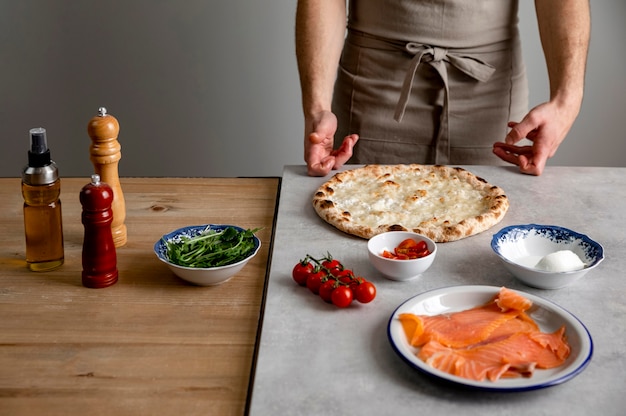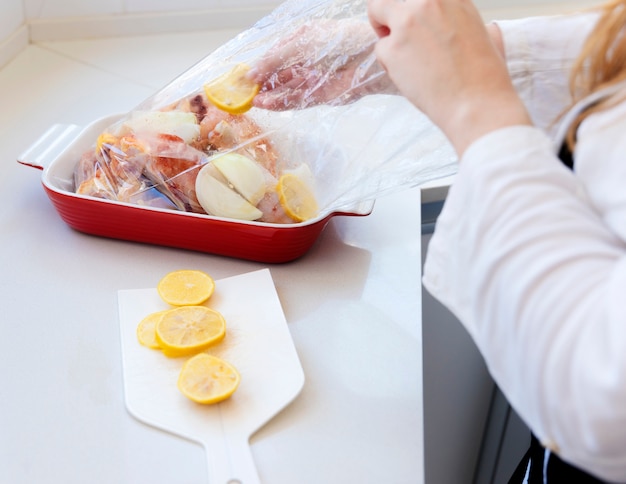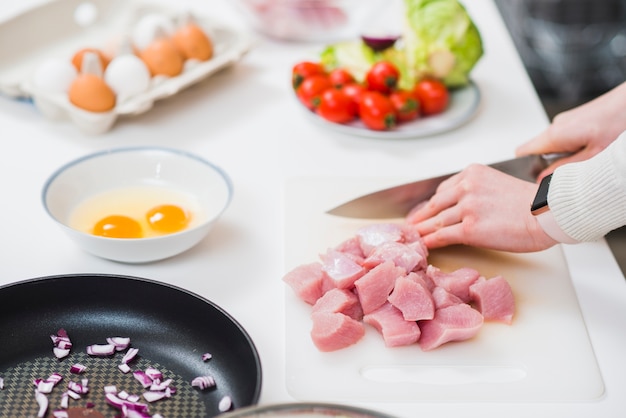(Part 1) The Basics: Setting the Stage

Safety First: Temperature Is King
It's not just about taste – it's about safety! No one wants to be on the receiving end of a food poisoning surprise. That’s why cooking your chicken breast to a safe internal temperature of 165°F (74°C) is absolutely non-negotiable. Think of it like the golden rule of chicken cooking.The Great Thaw: A Necessary Pre-Game
Ever tried cooking frozen chicken? It's like trying to make a snowman on a sunny day - it’s not going to happen. Always make sure your chicken breast is completely thawed before you start cooking. You want that chicken to cook evenly, not turn into a bizarre, frozen-in-the-middle situation.The Method Matters: Picking Your Path
Chicken breast is a chameleon, happy to adapt to any cooking style you throw at it. We’ll be exploring the most popular methods, from the classic pan-fry to the oh-so-trendy sous vide.(Part 2) Pan-Frying: The Classic Approach

How to Pan-Fry to Perfection
Hot Pan, Happy Chicken: Before you add the chicken, crank up the heat. We're talking medium-high heat, folks. A hot pan sears the outside, locking in flavor and creating that coveted crust. Grease the Wheels: A good tablespoon of oil is your friend. Olive oil, vegetable oil, or your favourite blend – choose wisely. Season Like a Pro: Don't be shy with the salt and pepper. A generous pinch is a good starting point. And don't forget other spices – paprika, garlic powder, onion powder, the possibilities are endless! Flip It, Don't Overcook It: For a standard 6-ounce (170-gram) chicken breast, you’re aiming for 4-5 minutes per side, flipping once the underside is golden and cooked. Your trusty meat thermometer is your best friend here. Rest is Golden: Give that chicken a little time to relax! A few minutes of resting will allow the juices to redistribute, making it even more tender and juicy.Tips to Elevate Your Pan-Frying Game
Don't Overcrowd the Party: Give each chicken breast enough space to cook evenly. The Thermometer is Your Guide: Use a meat thermometer to avoid overcooking or undercooking. Don't Be Afraid to Remove: Take that chicken off the heat as soon as it reaches 165°F (74°C). No need to push your luck!(Part 3) Baking: The No-Fuss Hero

The Baking Process: Simple and Delicious
Preheat for Success: Get that oven cranked up to 375°F (190°C). Season and Spread: Season generously with your favourite spices, then place the chicken on a baking sheet lined with parchment paper. This prevents sticking and ensures a clean-up that's a breeze. Time is of the Essence: For a standard 6-ounce (170-gram) chicken breast, you're looking at 20-25 minutes in the oven. Check and Double Check: Don't forget to use that trusty meat thermometer to make sure your chicken is cooked through.baking tips for the Perfect Breast
Add a Moisture Boost: A splash of broth or a few vegetables in the bottom of the pan can add a boost of flavour and moisture. Rest Time is Essential: Let that chicken rest for a few minutes after baking to lock in the juices.(Part 4) Roasting: A Celebration for the Senses
Roasting is a game-changer when you're feeding a crowd. It allows you to cook multiple chicken breasts at once, making it perfect for family dinners, potlucks, or any occasion where you need a satisfying and delicious meal.The Art of Roasting: Elevate Your Chicken Game
Oven Preheating: A Must: Turn your oven to 400°F (200°C). Season and Prep: Season those chicken breasts liberally with salt, pepper, and any spices that tickle your fancy. Place them on a roasting rack in a baking pan for even cooking. Cook Time: A standard 6-ounce (170-gram) chicken breast will take about 20-25 minutes to reach perfection. Internal Temperature Check: Always use a meat thermometer to ensure that internal temperature reaches 165°F (74°C).roasting tips: Take It Up a Notch
Space is Key: Give those chicken breasts enough space to breathe and cook evenly. Baste for Extra Flavor: For a truly indulgent experience, baste the chicken with butter or broth during the roasting process. This adds moisture and a beautiful golden hue.(Part 5) Grilling: For a Smoky Kiss of Flavor
Grilling is all about that smoky flavour that transports you to summer evenings and backyard barbeques. It's a fun and exciting way to cook chicken, and it's perfect for outdoor gatherings or when you're feeling adventurous in the kitchen.Grilling 101: Mastering the Art of the BBQ
Preheat Your Grill: Get those grill grates nice and hot, aiming for a medium-high heat. Season and Prep: Season your chicken breast generously with your favourite spices, then place it on the grill. Cook Time: For a standard 6-ounce (170-gram) chicken breast, you'll need to cook it for 5-7 minutes per side, flipping once the underside is golden. Don't forget to check for that all-important internal temperature of 165°F (74°C).grilling tips: Get Your Grill On
Cleanliness is Key: Brush those grill grates with a grill brush before cooking to prevent sticking. Don't Overdo It: Keep a watchful eye on your chicken and remove it from the grill as soon as it's cooked through.(Part 6) Sous Vide: The Precision Cooking Powerhouse
Sous vide is all about precision and control. This method involves submerging sealed food in a temperature-controlled water bath, ensuring that the meat cooks evenly and gently. It's a bit more involved, but it delivers consistently perfect results every time.The Sous Vide Process: A Step-by-Step Guide
Seal It Up: Place the chicken breast in a vacuum-sealed bag. You can also use a resealable plastic bag, but be sure to squeeze out as much air as possible. Water Bath Precision: Immerse the sealed bag in a water bath set to 145°F (63°C). Time for Tenderness: For a standard 6-ounce (170-gram) chicken breast, you'll need to cook it for 1-1.5 hours. The Final Touch: Searing: After sous vide cooking, sear the chicken breast in a hot pan for a few minutes to achieve that beautiful, crispy crust.Sous Vide Tips: Maximize Your Sous Vide Experience
Invest in an Immersion Circulator: This handy tool is essential for maintaining a stable temperature in your water bath. Don't Overcook It: Even with sous vide, it's possible to overcook your chicken. Remember to check the internal temperature using a meat thermometer.(Part 7) Avoiding Dry Chicken: A Culinary Crime Solved
We all know the feeling – a dry, rubbery chicken breast is a culinary tragedy. It's a recipe for disappointment, and it's something we want to avoid at all costs.The Keys to Moisture: A Guide to Tenderness
Don't Overcook It: Overcooking is the biggest culprit when it comes to dry chicken. Cook it to the perfect internal temperature of 165°F (74°C) and remove it from the heat as soon as it's done. Embrace the Marinade: Marinating the chicken breast in a flavorful mixture of oil, acid, and spices can help to tenderize the meat and add moisture. Brining 101: Brining, the art of soaking the chicken breast in a salt-water solution for a few hours, is a great way to retain moisture and improve flavor. Moisture Boost: Add a splash of liquid to your cooking pan or baking dish – broth, wine, or a simple mixture of water and lemon juice can work wonders.(Part 8) chicken breast recipes: Flavour Explosions in the Kitchen
Now that you’re equipped with the knowledge, let's turn those chicken breasts into culinary masterpieces!Lemon Herb Chicken with Roasted Vegetables: A Fresh and Flavorful Delight
Ingredients: 2 boneless, skinless chicken breasts 1 tablespoon olive oil 1 lemon, juiced 1 tablespoon chopped fresh herbs (such as parsley, thyme, or rosemary) Salt and pepper to taste 1 cup mixed vegetables (such as broccoli, carrots, and bell peppers)Instructions:1. Preheat your oven to 400°F (200°C).2. In a bowl, combine the olive oil, lemon juice, herbs, salt, and pepper. 3. Add the chicken breasts to the bowl and coat them in the marinade. 4. Arrange the chicken breasts and vegetables on a baking sheet lined with parchment paper. 5. Bake for 20-25 minutes, or until the chicken is cooked through and the vegetables are tender.Creamy Garlic Parmesan Chicken: A Creamy Indulgence
Ingredients: 2 boneless, skinless chicken breasts 1 tablespoon olive oil 2 cloves garlic, minced 1/2 cup heavy cream 1/4 cup grated Parmesan cheese Salt and pepper to tasteInstructions:1. Heat the olive oil in a large skillet over medium heat.2. Add the chicken breasts and cook for 5-7 minutes per side, or until golden brown and cooked through.3. Remove the chicken from the skillet and set it aside. 4. Add the minced garlic to the skillet and cook for 1 minute.5. Pour in the heavy cream and bring it to a simmer.6. Stir in the Parmesan cheese until it melts.7. Season with salt and pepper to taste.8. Return the chicken breasts to the skillet and coat them with the creamy sauce.9. Serve immediately over your favourite pasta or rice.(Part 9) FAQs: Chicken Breast Questions Answered
You’ve got questions, I’ve got answers. Let’s address some common chicken breast queries.
1. How long should I cook a chicken breast?
The cooking time for a chicken breast varies depending on the method you’re using. As a general rule, a 6-ounce (170-gram) chicken breast will take about 4-5 minutes per side for pan-frying, 20-25 minutes for baking or roasting, 5-7 minutes per side for grilling, and 1-1.5 hours for sous vide. Remember, always check the internal temperature with a meat thermometer to ensure the chicken is cooked through.
2. How do I know if my chicken breast is cooked through?
The most reliable way to determine if your chicken breast is cooked through is to use a meat thermometer. Insert the thermometer into the thickest part of the breast, making sure it doesn’t touch any bone. The internal temperature should reach 165°F (74°C). Another visual cue is that the chicken juices should run clear when you pierce it with a fork.
3. What if my chicken breast is dry?
It’s a common problem, but don’t despair! You can still salvage a dry chicken breast by adding a flavorful sauce or gravy. You can also try shredding it and incorporating it into a salad or sandwich. Next time, remember those tips for avoiding dry chicken!
4. Can I freeze chicken breast?
Absolutely! You can freeze chicken breast for up to 2-3 months. To freeze it, wrap the breast tightly in plastic wrap or aluminum foil, then place it in a freezer-safe bag. To thaw it, transfer it from the freezer to the refrigerator and allow it to thaw overnight. It’s a great way to have chicken on hand for quick and easy meals.
5. What are some healthy ways to cook chicken breast?
You’ve got plenty of options! Baking, grilling, and poaching are all excellent choices for preparing chicken breast without adding too much fat. You can also opt for skinless breasts, which are naturally lower in fat. Just remember to use a meat thermometer to ensure it’s cooked through.
I hope this ultimate guide to chicken breast cooking time has been helpful. Remember, the key to success is to choose a method you enjoy, follow the guidelines for cooking time and temperature, and have fun! Happy cooking!
Everyone is watching

Corn on the Cob: The Ultimate Guide to Perfectly Cooked Ears
Healthy MealsAh, corn on the cob. Just the name evokes images of sunny days, barbecues, and that sweet, juicy flavour that ...

Perfect Pork Roast Oven Cooking Time: A Guide to Delicious Results
Healthy MealsThere's something truly satisfying about a perfectly roasted pork. The aroma alone is enough to make your mout...

Ham Cooking Time: How Long to Bake, Smoke, or Boil a Delicious Ham
Healthy MealsAh, ham. It's a classic, isn't it? A real crowd-pleaser, especially around holidays. And when done right, it'...

Scallops: The Ultimate Guide to Perfect Cooking
Healthy MealsAh, scallops. Those delicate, sweet, and utterly delicious morsels of the sea. They hold a special place in my...

Spaghetti Squash: The Ultimate Guide to Cooking and Serving
Healthy MealsRemember that time you saw spaghetti squash at the supermarket, looking all bumpy and strange, and thought, "W...
